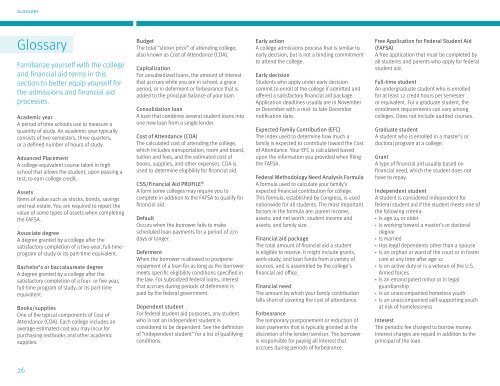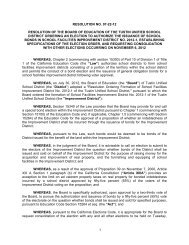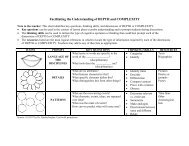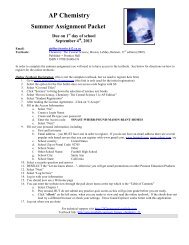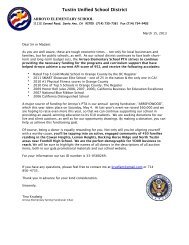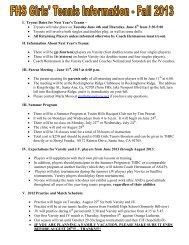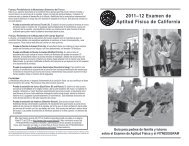College Planning - Tustin Unified School District
College Planning - Tustin Unified School District
College Planning - Tustin Unified School District
You also want an ePaper? Increase the reach of your titles
YUMPU automatically turns print PDFs into web optimized ePapers that Google loves.
glossary<br />
Glossary<br />
Familiarize yourself with the college<br />
and financial aid terms in this<br />
section to better equip yourself for<br />
the admissions and financial aid<br />
processes.<br />
Academic year<br />
A period of time schools use to measure a<br />
quantity of study. An academic year typically<br />
consists of two semesters, three quarters,<br />
or a defined number of hours of study.<br />
Advanced Placement<br />
A college-equivalent course taken in high<br />
school that allows the student, upon passing a<br />
test, to earn college credit.<br />
Assets<br />
Items of value such as stocks, bonds, savings<br />
and real estate. You are required to report the<br />
value of some types of assets when completing<br />
the FAFSA.<br />
Associate degree<br />
A degree granted by a college after the<br />
satisfactory completion of a two-year, full-time<br />
program of study or its part-time equivalent.<br />
Bachelor’s or baccalaureate degree<br />
A degree granted by a college after the<br />
satisfactory completion of a four- or five-year,<br />
full-time program of study, or its part-time<br />
equivalent.<br />
Books/supplies<br />
One of the typical components of Cost of<br />
Attendance (COA). Each college includes an<br />
average estimated cost you may incur for<br />
purchasing textbooks and other academic<br />
supplies.<br />
Budget<br />
The total “sticker price” of attending college;<br />
also known as Cost of Attendance (COA).<br />
Capitalization<br />
For unsubsidized loans, the amount of interest<br />
that accrues while you are in school, a grace<br />
period, or in deferment or forbearance that is<br />
added to the principal balance of your loan.<br />
Consolidation loan<br />
A loan that combines several student loans into<br />
one new loan from a single lender.<br />
Cost of Attendance (COA)<br />
The calculated cost of attending the college,<br />
which includes transportation, room and board,<br />
tuition and fees, and the estimated cost of<br />
books, supplies, and other expenses. COA is<br />
used to determine eligibility for financial aid.<br />
CSS/Financial Aid PROFILE ®<br />
A form some colleges may require you to<br />
complete in addition to the FAFSA to qualify for<br />
financial aid.<br />
Default<br />
Occurs when the borrower fails to make<br />
scheduled loan payments for a period of 270<br />
days or longer.<br />
Deferment<br />
When the borrower is allowed to postpone<br />
repayment of a loan for as long as the borrower<br />
meets specific eligibility conditions specified in<br />
the law. For subsidized federal loans, interest<br />
that accrues during periods of deferment is<br />
paid by the federal government.<br />
Dependent student<br />
For federal student aid purposes, any student<br />
who is not an independent student is<br />
considered to be dependent. See the definition<br />
of “independent student” for a list of qualifying<br />
conditions.<br />
Early action<br />
A college admissions process that is similar to<br />
early decision, but is not a binding commitment<br />
to attend the college.<br />
Early decision<br />
Students who apply under early decision<br />
commit to enroll at the college if admitted and<br />
offered a satisfactory financial aid package.<br />
Application deadlines usually are in November<br />
or December with a mid- to late-December<br />
notification date.<br />
Expected Family Contribution (EFC)<br />
The index used to determine how much a<br />
family is expected to contribute toward the Cost<br />
of Attendance. Your EFC is calculated based<br />
upon the information you provided when filing<br />
the FAFSA.<br />
Federal Methodology Need Analysis Formula<br />
A formula used to calculate your family’s<br />
expected financial contribution for college.<br />
This formula, established by Congress, is used<br />
nationwide for all students. The most important<br />
factors in the formula are: parent income,<br />
assets, and net worth; student income and<br />
assets; and family size.<br />
Financial aid package<br />
The total amount of financial aid a student<br />
is eligible to receive. It might include grants,<br />
work-study, and loan funds from a variety of<br />
sources, and is assembled by the college’s<br />
financial aid office.<br />
Financial need<br />
The amount by which your family contribution<br />
falls short of covering the cost of attendance.<br />
Forbearance<br />
The temporary postponement or reduction of<br />
loan payments that is typically granted at the<br />
discretion of the lender/servicer. The borrower<br />
is responsible for paying all interest that<br />
accrues during periods of forbearance.<br />
Free Application for Federal Student Aid<br />
(FAFSA)<br />
A free application that must be completed by<br />
all students and parents who apply for federal<br />
student aid.<br />
Full-time student<br />
An undergraduate student who is enrolled<br />
for at least 12 credit hours per semester<br />
or equivalent. For a graduate student, the<br />
enrollment requirements can vary among<br />
colleges. Does not include audited courses.<br />
Graduate student<br />
A student who is enrolled in a master’s or<br />
doctoral program at a college.<br />
Grant<br />
A type of financial aid usually based on<br />
financial need, which the student does not<br />
have to repay.<br />
Independent student<br />
A student is considered independent for<br />
federal student aid if the student meets one of<br />
the following criteria:<br />
··<br />
Is age 24 or older<br />
··<br />
Is working toward a master’s or doctoral<br />
degree<br />
··<br />
Is married<br />
··<br />
Has legal dependents other than a spouse<br />
··<br />
Is an orphan or ward of the court or in foster<br />
care at any time after age 12<br />
··<br />
Is on active duty or is a veteran of the U.S.<br />
Armed forces<br />
··<br />
Is an emancipated minor or in legal<br />
guardianship<br />
··<br />
Is an unaccompanied homeless youth<br />
··<br />
Is an unaccompanied self-supporting youth<br />
at risk of homelessness<br />
Interest<br />
The periodic fee charged to borrow money.<br />
Interest charges are repaid in addition to the<br />
principal of the loan.<br />
26


